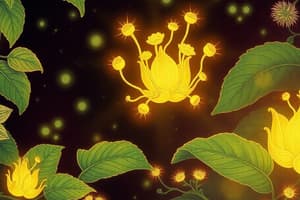Podcast
Questions and Answers
What is the role of chloroplasts?
What is the role of chloroplasts?
Convert light energy to chemical energy through photosynthesis.
What is chlorophyll?
What is chlorophyll?
A pigment that traps light energy; appears green; inside the thylakoid membrane.
What are carotenoids?
What are carotenoids?
Orange and yellow pigments that absorb light.
Describe the membrane structure of chloroplasts.
Describe the membrane structure of chloroplasts.
What is the stroma?
What is the stroma?
What is the thylakoid lumen?
What is the thylakoid lumen?
What is photosynthesis?
What is photosynthesis?
What is the overall reaction for photosynthesis?
What is the overall reaction for photosynthesis?
Where are chloroplasts found?
Where are chloroplasts found?
Describe the organization of the thylakoid membrane.
Describe the organization of the thylakoid membrane.
What are thylakoids?
What are thylakoids?
What are grana?
What are grana?
What is the thylakoid membrane?
What is the thylakoid membrane?
What are pigments?
What are pigments?
Describe the structure of chlorophyll.
Describe the structure of chlorophyll.
How do chlorophyll A and B differ?
How do chlorophyll A and B differ?
What is the strongest biological oxidizing agent?
What is the strongest biological oxidizing agent?
What is the strongest biological reducing agent?
What is the strongest biological reducing agent?
What are antenna complexes?
What are antenna complexes?
What happens to light energy when it reaches the reaction center?
What happens to light energy when it reaches the reaction center?
How are photosystems I and II connected?
How are photosystems I and II connected?
An electron that enters the ETC comes from?
An electron that enters the ETC comes from?
Where is the proton gradient located?
Where is the proton gradient located?
The ETC is coupled to the movement of protons across the thylakoid membrane because?
The ETC is coupled to the movement of protons across the thylakoid membrane because?
Where does the production of ATP take place?
Where does the production of ATP take place?
Where does the Calvin cycle take place?
Where does the Calvin cycle take place?
What is photolysis?
What is photolysis?
What drives ATP synthase activity in photosynthesis?
What drives ATP synthase activity in photosynthesis?
Where does ATP synthase project into?
Where does ATP synthase project into?
Flashcards are hidden until you start studying
Study Notes
Chloroplasts and Photosynthesis
- Chloroplasts convert light energy into chemical energy through photosynthesis.
- Chlorophyll is the green pigment located inside the thylakoid membrane that traps light energy.
- Carotenoids are orange and yellow pigments that absorb light and transfer energy to chlorophyll a.
- Chloroplast membranes consist of an inner membrane, outer membrane with pores, and thylakoid membrane enclosing the thylakoid lumen.
- The stroma is a fluid-filled space in the chloroplast that contains enzymes and the internal thylakoid membrane system; comparable to the mitochondrial matrix.
- The thylakoid lumen is the innermost compartment of chloroplasts, filled with fluid.
- Photosynthesis transforms light energy into chemical energy, creating carbohydrates and oxygen.
- The overall photosynthesis reaction is: 6 CO2 + H2O → glucose + 6 O2; CO2 is reduced in this process.
- Chloroplasts are primarily found in mesophyll cells of leaves, which contain air spaces and water vapor.
- The thylakoid membrane organizes into stacks called grana, where pigments and electron acceptors are embedded.
- Thylakoids are disc-like sacs suspended in the stroma, interconnected for efficient functioning.
- Grana refer to the stacked structures of thylakoid sacs.
- The thylakoid membrane encloses the thylakoids and is crucial for ATP synthesis.
- Pigments absorb light at distinct wavelengths and play key roles in photosynthesis.
- Chlorophyll is structured with a porphyrin ring that absorbs light and contains magnesium, with a long hydrocarbon side chain for membrane anchoring.
- Chlorophyll A and B differ by their terminal group: A has a methyl group and appears bright green, while B has a carbonyl group and appears green/yellow.
- P680+ is the strongest biological oxidizing agent, while P700, activated by light, is the strongest biological reducing agent.
- Antenna complexes, made of chlorophyll and other pigments, act like "satellite dishes" for trapping photons, located in the thylakoid membrane with a reaction center at their core.
- Resonance transfer occurs in the reaction center, where energy from absorbed photons is passed among pigments until reaching the reaction center.
- The reaction center consists of a special chlorophyll pair, absorbing at the longest wavelengths and promoting an electron to a higher energy state for donation to an electron acceptor.
- Photosystems I and II are connected via the electron transport chain (ETC).
- Electrons entering the ETC originate from P680 molecules in the reaction center of photosystem II.
- A proton gradient exists across the thylakoid membrane, with pH in the thylakoid lumen at 5 and in the stroma at 8.
- The ETC is coupled with proton movement across the thylakoid membrane, as energy released by electrons is used to pump protons into the thylakoid lumen.
- ATP production occurs in the stroma, utilizing ATP synthase activity.
- The Calvin cycle, responsible for carbon fixation, takes place in the stroma.
- Photolysis is the process where light energy splits water into an oxygen molecule and two protons, aiding proton gradient maintenance.
- ATP synthase activity in photosynthesis is driven by the proton motive force and its projection into the stroma.
Studying That Suits You
Use AI to generate personalized quizzes and flashcards to suit your learning preferences.



